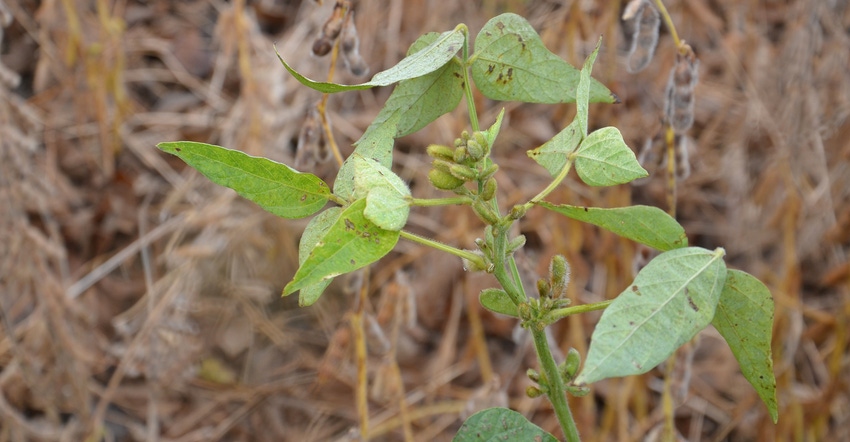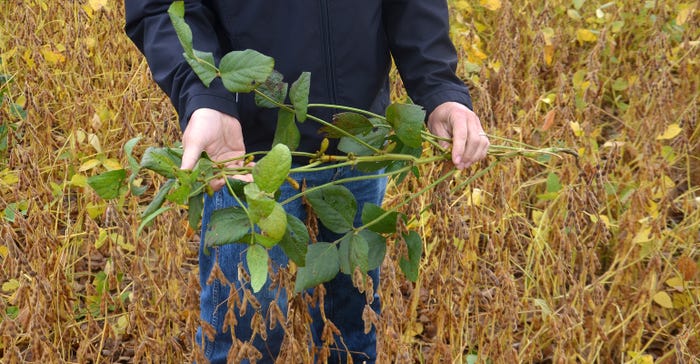
Editor’s note: When this story first appeared, sources were unaware that some plant specimens similar to those shown with the story were sent to the Purdue University Plant and Pest Diagnostic Laboratory and tested negative for the tobacco ringspot virus of soybean. Sources stand by the story. However, it’s important to note that tobacco ringspot virus has yet to be confirmed in Indiana by a plant diagnostic lab as of Oct. 28. Purdue Extension disease specialist Darcy Telenko says it is possible similar symptoms could be caused by environmental conditions. It’s also possible that the plants referred to here were infected by tobacco ringspot virus, but that was not confirmed by testing.
If you see plants infected with tobacco ringspot virus of soybean, you won’t miss them. And you likely won�’t forget about them either. They take on a weird appearance, similar to crazy top in corn. Where pods should be, something else develops that shouldn’t be there.
In corn infected with crazy top, typically an erratic growth of leaf tissue appears instead of a tassel. In the case of tobacco ringspot virus, or TRSV, a telltale symptom is often a tiny bunch of very short pods trying to develop in a clump on an upper node of the soybean plant. If the rest of the field is nearly mature, plants afflicted with this ailment will stand out because they’re still standing and as green as grass.
“I had never seen the disease myself until this season,” says Steve Gauck, a veteran sales agronomist with Beck’s, based near Greensburg, Ind. “I got a couple reports of it from customers in Johnson County, and I also got a report from someone who found it in northern Indiana.
“Then I found it on Oct. 7 in the Soybean Watch ’19 field in Johnson County.” Beck’s sponsors Soybean Watch ’19. “That same day, I also found it in a field in Jackson County,” he adds.
While infected plants are far too scattered to impact yield, the disease is hard to miss if it’s in a field, Gauck says. Infected plants have few pods. They stay green longer because there are virtually no beans for the plant to feed sugars to, so sugars remain in stems. A few pods may have one or more beans in them. They seldom mature, however.
In the Soybean Watch ’19 field, Gauck found TRSV in all three varieties in the field, so it’s obviously not variety-specific. Seed in the field came from two different companies.
More details
After she was forwarded a picture of a plant from the Soybean Watch ’19 field, Darcy Telenko, Purdue University Extension disease specialist, indicated the disease was likely tobacco ringspot virus of soybean. She notes that she hasn’t seen it very often.

GREEN PLANT, FEW PODS: You won’t fill the combine hopper from this plant. It’s likely infected with tobacco ringspot virus of soybean. There are few pods on the plant, and the beans usually don’t mature.

If you want to learn more about this strange affliction, Telenko suggests visiting this page on the Crop Protection Network website. The website is developed and sponsored by an organization of land-grant universities.
TRSV can be transmitted through infected seed and by insect feeding. Perhaps that’s the key to why it appeared in 2019, especially in southern Indiana — it tends to be favored by hot, dry weather. Those conditions dominated the latter part of the season in much of the state, even in northern Indiana, until a late September storm brought rain to the northern one-third of the state.
Rotation to corn can help control the disease, Telenko notes. You also want to make sure you’re buying clean seed.
About the Author(s)
You May Also Like




